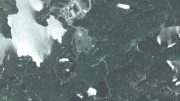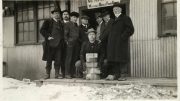Please allow me to begin with a little trivia. When I started in this business the Prime Minister of Canada was Louis St. Laurent. Anybody out there remember him? Suffice it to say, most 70- to 80-year-olds are neither nimble nor quick, and I am no exception.
Let’s begin this story when, at a somewhat sprightly 70, I initiated a prospecting effort in B.C.’s Nehalliston plateau, an upland region rising westerly from the North Fork of the Thompson River valley, about 100 km north of Kamloops.
My modus operandi is unsophisticated – it certainly does not involve reassembling drifted tectonic plates. I simply pick prospective areas based on what I believe is favourable geology, particularly where major fault zones occur.
The Nehalliston plateau appears to be a very attractive locale, underlain by the Nicola volcanic section, with numerous structures and mineral showings all over the place. My prospecting method is even simpler than my area selection, mainly involving long walks on logging trails commonly found in B.C.
For almost two field seasons I wandered through the Nicola volcanics, and found many interesting copper-gold showings. However, every one was staked with long holding periods.
Discouraged, I moved my work to the north part of the plateau, an area underlain by Fennell volcanic rocks, which are not considered to be nearly as fashionable a neighbourhood as the Nicola, and have very few documented mineral showings.
And I became totally disappointed after spending another season in this area with nothing to show but one puny, mineralized quartz vein that assayed 20 parts per billion gold.
I finally ended this whole effort in 2005 with one last day to prospect the only logging trail in the northern plateau that I had not yet covered. In this locality bedrock is extensively covered by deep glacial overburden, thought by government geologists to be terminal moraine material.
In recent years the area has been clear-cut to combat pine beetle infestation, so what we have is a hummocky terrain containing large rafted boulders, but with almost no outcrop. Because of the residual glacial pits, and the extensive logging, the area resembles a wasteland, somewhat like Hiroshima after the bomb.
My final day’s work took me to the last unexplored trail located 13 km west of Clearwater Village. After driving my four-by-four truck only 400 metres off the main logging road onto a trail, I ran into a small exposure of iron oxide gossan in volcanic host rock, which would have inspired any geologist or prospector to have a closer look.
The gossan was strongly silicified, and breaking the rock indicated very high sulfide content, mostly pyrrhotite. Strewn along the trail were large boulders of massive pyrrhotite with minor chalcopyrite. Obviously, this rock had been exposed during excavation of the trail a few years before.
Although the gossan looked interesting, I figured that many geologists would have sampled it. I did not have high expectations, but it prompted me to quickly prospect a larger area around the showing. No outcrop was found, but I did find mineralized float here and there.
Several weeks later I was flabbergasted when I received assay results. The gossan rock assayed between 10 grams and 27 grams gold per tonne, along with significant bismuth and copper.
My first reaction was to call Acme Labs to be sure that these assays were indeed from my samples. These guys do very
good work, and they assured me that there was no mix-up. Then, I immediately staked some claims to cover this almost wide-open area, which I named the Jake property.
For the rest of the season and into the fall, I undertook detailed prospecting. This again led to no outcrop discoveries, but at several localities distant from the discovery, weakly anomalous gold-bearing float was found. The general picture here was a very tiny island of ore grade rock surrounded by a virtual sea of mostly deep glacial overburden, with some scattered anomalous float found around the area, but no bedrock to be seen. The critical question was: Did this gossan represent bedrock, or was it glacially transported?
Shortly after showing the discovery to former B.C. Ministry of Energy and Mines geologist Mike Cathro, interest developed in the property, and not long after that the Jake Claim Group was optioned by the highly regarded, Vancouver junior company, Rimfire Minerals.
Rimfire soon began conducting geophysical surveying followed by trenching along the trail where the discovery was made. The trenching indicated that the gossan represented broken capping over bedrock, and good gold values were encountered.
Fortunately, the overburden in the immediate discovery area proved only a few metres thick.
To make a long story short, after several years of grassroots work and scout drilling by Rimfire and a partner, the claims were returned to my ownership in 2009.
Fortunately, I had the means to continue the project, albeit by what I call slow-motion exploration. Basically, I was left with the partially drilled discovery showing, which carried high grade gold, but only over widths of two metres or so, and several untested induced-polarization anomalies under alluvial cover. My subsequent work, beginning with one of these large anomalies, indicates that it’s a high sulfide zone with gold values. So the beat goes on.
People often ask me why I still do what I do. Am I some kind of nutcase? The answer is, probably yes.
But I often think of the lyrics from “On the Street Where You Live” in the musical My Fair Lady. Considering the thousands of kilometres I have walked alone on B.C. logging trails, “I Have Often Walked Down this Street Before” is appropriate, and later in the score, “There’s Nowhere Else on Earth I Would Rather Be.”
As I approach 78, the work does at least provide some excitement, and it beats the hell out of mall walking. But, perhaps, an accompanying geriatric nurse or sampler might be helpful.
– The author, a geologist and professional engineer, resides in Spokane, Wash.




Be the first to comment on "Odds ‘n’ sods: No country for old men – or maybe one"